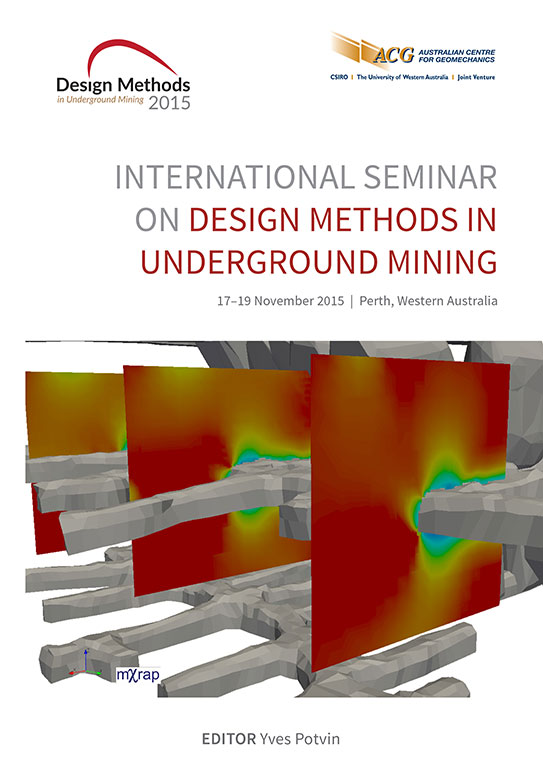Discrete analysis of open stope stability

|
Authors: Sainsbury, B; Sainsbury, D; Vakili, A |
DOI https://doi.org/10.36487/ACG_rep/1511_01_Sainsbury
Cite As:
Sainsbury, B, Sainsbury, D & Vakili, A 2015, 'Discrete analysis of open stope stability', in Y Potvin (ed.), Design Methods 2015: Proceedings of the International Seminar on Design Methods in Underground Mining, Australian Centre for Geomechanics, Perth, pp. 79-94, https://doi.org/10.36487/ACG_rep/1511_01_Sainsbury
Abstract:
The established (industry standard) practice to design stable stope spans in jointed rock is to use empirical methods. Experience at a number of open stoping operations has shown that empirical methods can produce unreliable and ambiguous results when applied to particular geological settings. A numerical modelling methodology has been developed and validated for a case study of hanging wall overbreak at a narrow vein open stoping operation. In this case, the methodology has proven successful in simulating the historical stope performance through the analysis of the actual stope geometry, stope wall orientations, extraction sequence, in situ stresses, discrete joint fabric and rock mechanical properties.
References:
Andrieux, PP, Brummer, RK, Li, H & O’Connor, CP 2007, ‘Elastic versus inelastic numerical modelling of deep and highly stresses mining fronts’, in Y Potvin (ed.), Proceedings of the Fourth International Seminar on Deep and High Stress Mining (Deep Mining ’07), Australian Centre for Geomechanics, Perth, pp. 51-64.
Berry, M & McCarthy, P 2006, ‘Practical consequences of geological uncertainty’, Proceedings of the Sixth International Mining Geology Conference, The Australasian Institute of Mining and Metallurgy, Melbourne, pp. 253-258.
Bewick, R & Kaiser, PK 2009, ‘Numerical assessment of factor B in Mathews’ method for open stope design’, in M Diederichs &
G Grasselli (eds), Proceedings of the Third Canada-US Rock Mechanics Symposium and the 20th Canadian Rock Mechanics Symposium (RockEng09), pp. 89-90.
Cai, M, Kaiser, PK, Tasaka, Y & Minami, M 2007, ‘Determination of residual strength parameters of jointed rock masses using the GSI system’, International Journal of Rock Mechanics and Mining Sciences, vol. 44, pp. 247-265.
Capes, G 2009, ‘Open stope hangingwall design based on general and detailed data collection in rock masses with unfavourable hangingwall conditions’ PhD thesis, University of Saskatchewan.
Cepuritis, P & Villaescusa, E 2012, ‘A reliability-based approach to open stope span design in underground mining’, Proceedings of the 6th International Conference and Exhibition on Mass Mining (MassMin 2012), Canadian Institute of Mining, Metallurgy and Petroleum, Westmount, QC, CD-Rom only.
Clark, LM & Pakalnis, RC 1997, ‘An empirical design approach for estimating unplanned dilution from open stope hangingwalls and footwalls’, Proceedings of the CIM 99th Annual General Meeting, Canadian Institute of Mining, Metallurgy and Petroleum, Westmount, QC.
Martin, CD 1997, ‘Seventeenth Canadian Geotechnical Colloquium: The effect of cohesion loss and stress path on brittle rock strength’, Canadian Geotechnical Journal, vol. 34, no. 5, pp. 698-725.
Martin, CD, Tannant, DD, Yazici, S & Kaiser, PK 1999, ‘Stress path and instability around mine openings’, Proceedings of the 9th ISRM Congress, International Society for Rock Mechanics, pp. 25-28.
Matthews, KE, Hoek, E, Wyllie, DC & Stewart, S 1981, Prediction of stable excavation spans for mining at depths below 1,000 metres in hard rock / Golder Associates, CANMET Library & Documentation Services Division, Vancouver.
Mawdesley, C, Trueman, R & Whiten, WJ 2001, ‘Extending the Mathews stability graph for open stope design’, Mining Technology, vol. 110, no. 1, pp. 27-39.
Oddie, ME & Pascoe, MJ 2005, ‘Stope performance at Olympic Dam Mine’, Proceedings of the Ninth Underground Operators’ Conference, The Australasian Institute of Mining and Metallurgy, Melbourne, pp. 265-272.
Parrott, T & Keall, P 2010, Stope performance in challenging ground conditions: observed versus predicted – a case study, Proceedings of the Second Australasian Ground Control in Mining Conference, The Australasian Institute of Mining and Metallurgy, Melbourne, 9 p.
Potvin, Y 1988, ‘Empirical open stope design in Canada’ PhD thesis, University of British Columbia.
Sainsbury, B, Sainsbury, D, Western, J, Petrie, P & Mutton, V 2014, ‘Pillar recovery adjacent to stabilised rockfill at the Ballarat Gold Project’, Proceedings of the Third Australasian Ground Control in Mining Conference (AusRock 2014), The Australasian Institute of Mining and Metallurgy, Melbourne, Paper no. 29.
Sharp, J 2011, ‘Applicability of the Mathews stability method to open stope stability assessment at Olympic Dam Mine’ Masters thesis, University of Canterbury.
Sprott, D, Toppi, M, Yi, X & Bawden, WF 1999, ‘The incorporation of stress induced damage factor into the Mathew's stability graph’, Proceedings of the CIM 101st Annual General Meeting, Canadian Institute of Mining, Metallurgy and Petroleum, Westmount, Quebec.
Stewart, PC & Trueman, R 2008, ‘Strategies for minimising and predicting dilution in narrow-vein mines – NVD Method’, Proceedings of the Narrow Vein Mining Conference, The Australasian Institute of Mining and Metallurgy, Melbourne,
pp. 153-164.
Suorineni, F 2010, ‘The stability graph after three decades in use: experiences and the way forward’, International Journal of Mining, Reclamation and Environment, vol. 24, no. 4, pp. 307-339.
Suorineni, FT, Tannant, DD & Kaiser, PK 1999, ‘Determination of fault-related sloughage in open stopes’, International Journal of Rock Mechanics and Mining Sciences, vol. 36, no. 7, pp. 891-906.
Vongpaisal, S, Li, G, Pakalnis, R & Brady, T 2009, ‘New 3D engineering curves for predicting stope stability and mining dilution in longitudinal blasthole mining operations’, International Journal of Mining, Reclamation and Environment, vol. 23, no. 2,
pp. 92-102.
© Copyright 2025, Australian Centre for Geomechanics (ACG), The University of Western Australia. All rights reserved.
View copyright/legal information
Please direct any queries or error reports to repository-acg@uwa.edu.au
View copyright/legal information
Please direct any queries or error reports to repository-acg@uwa.edu.au